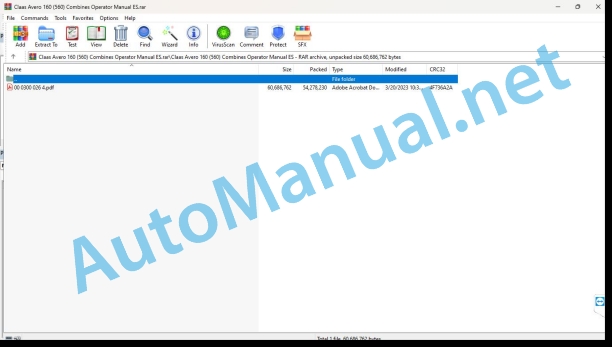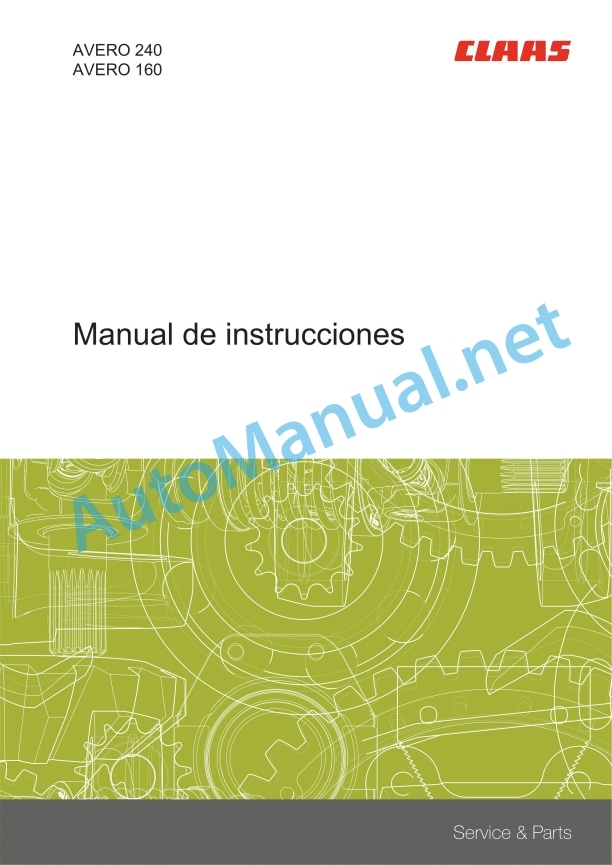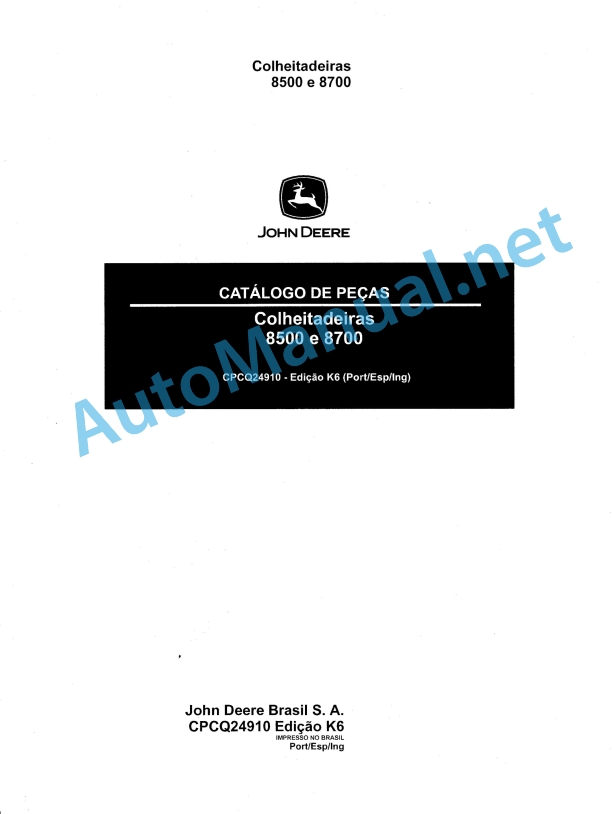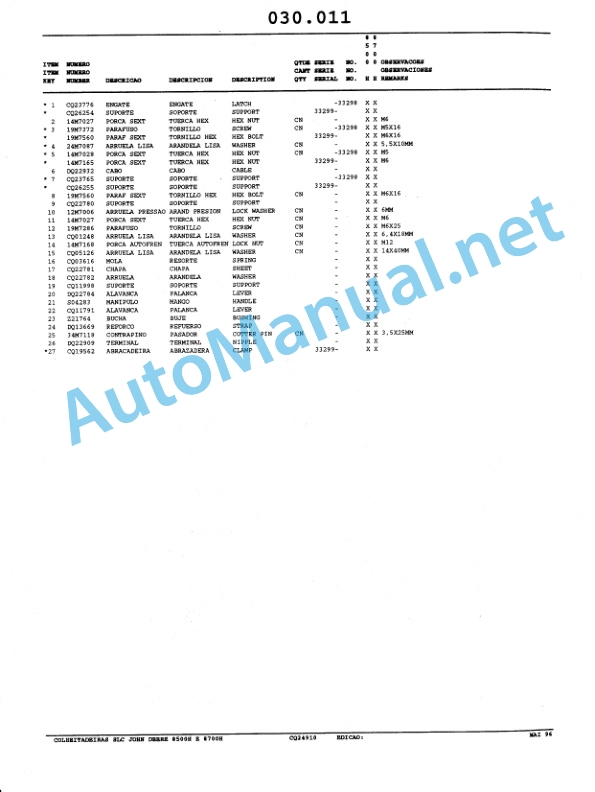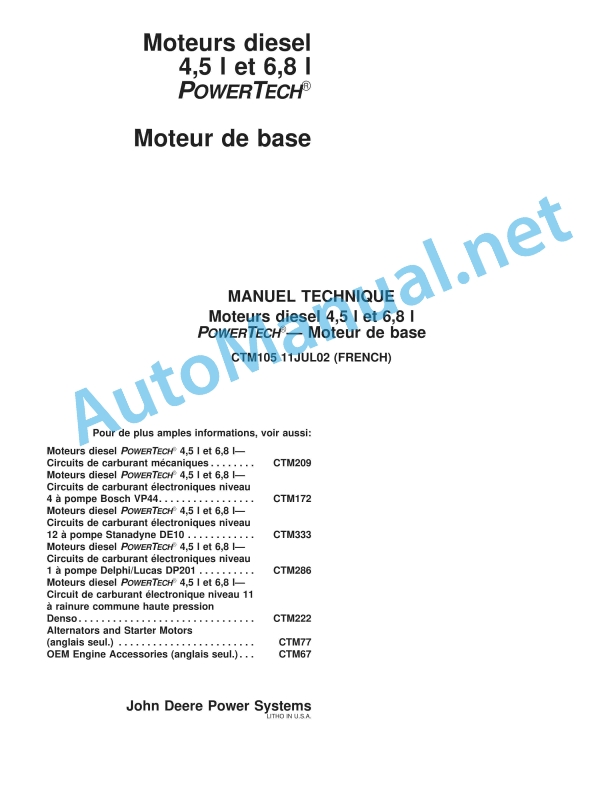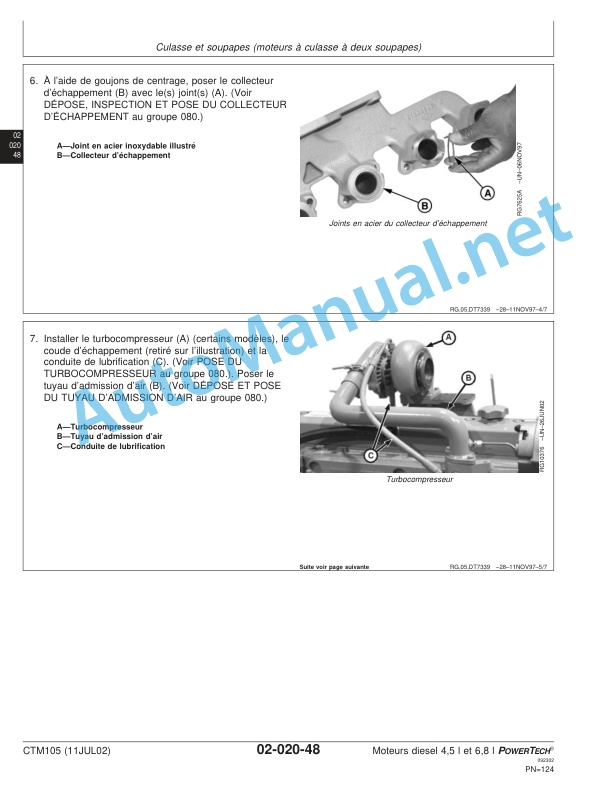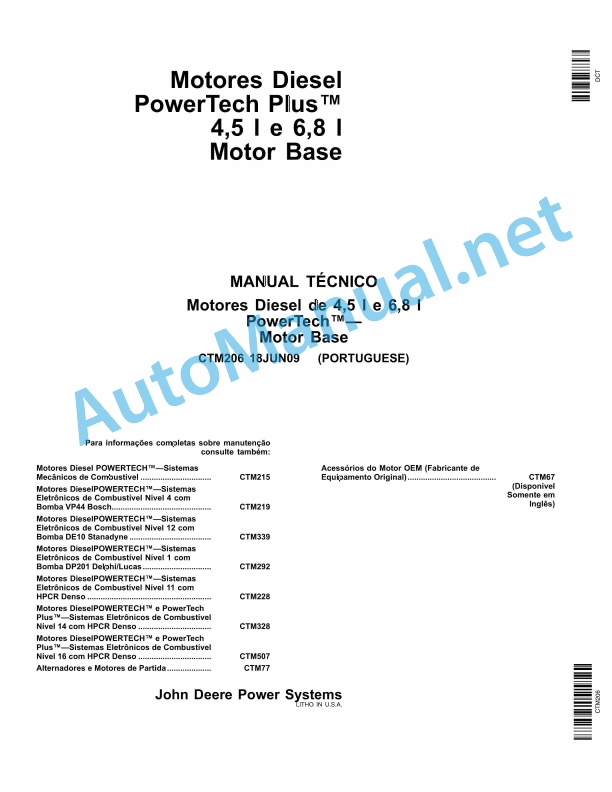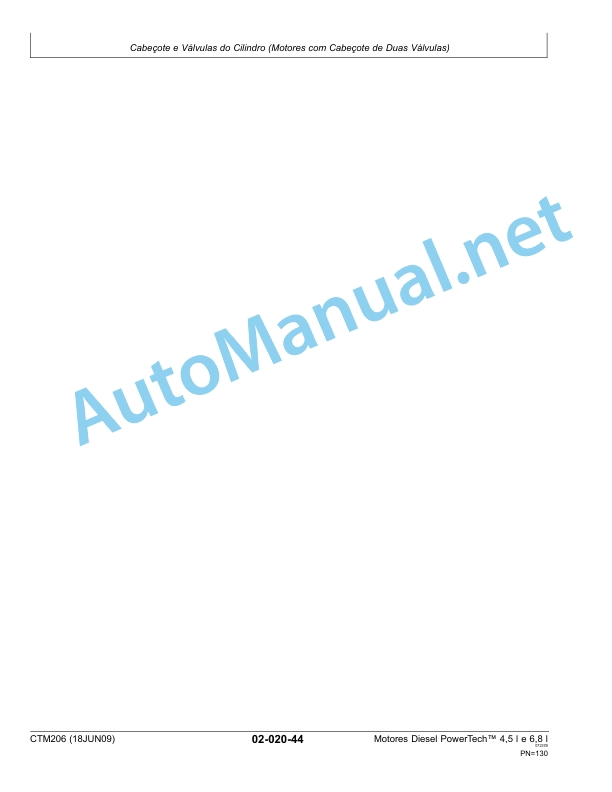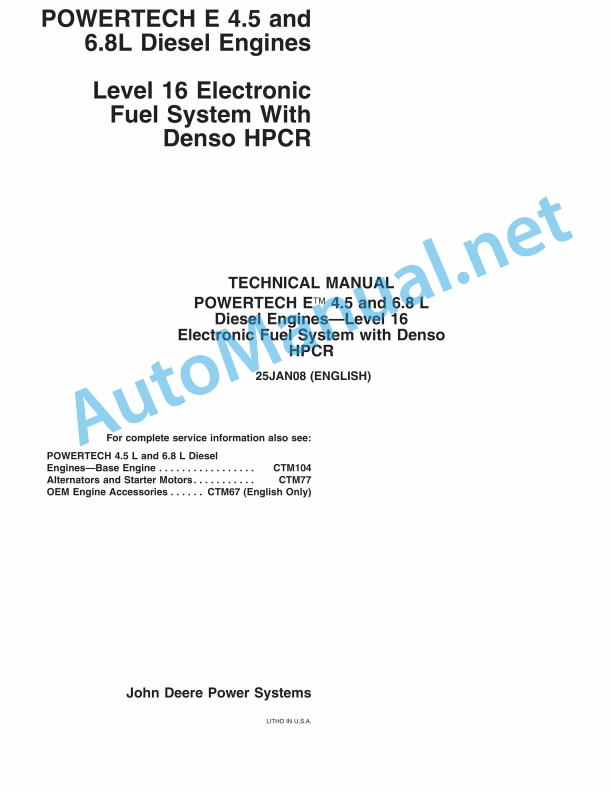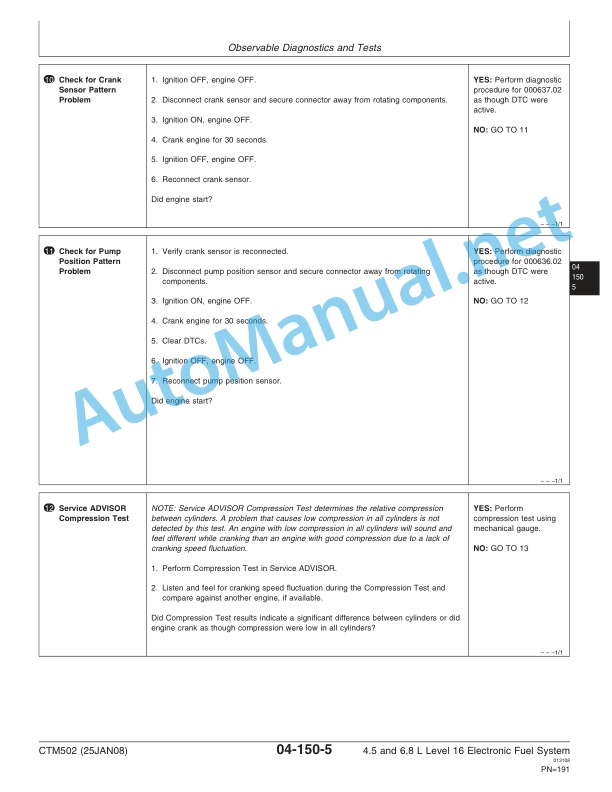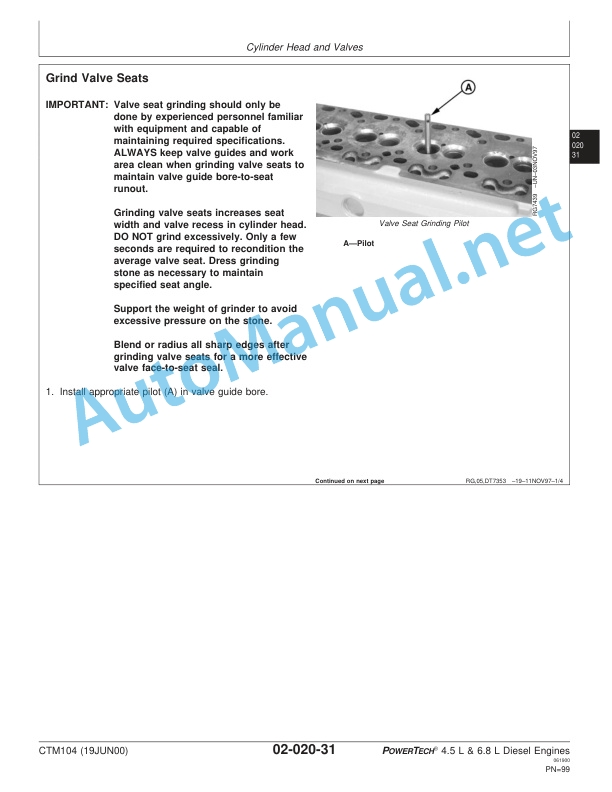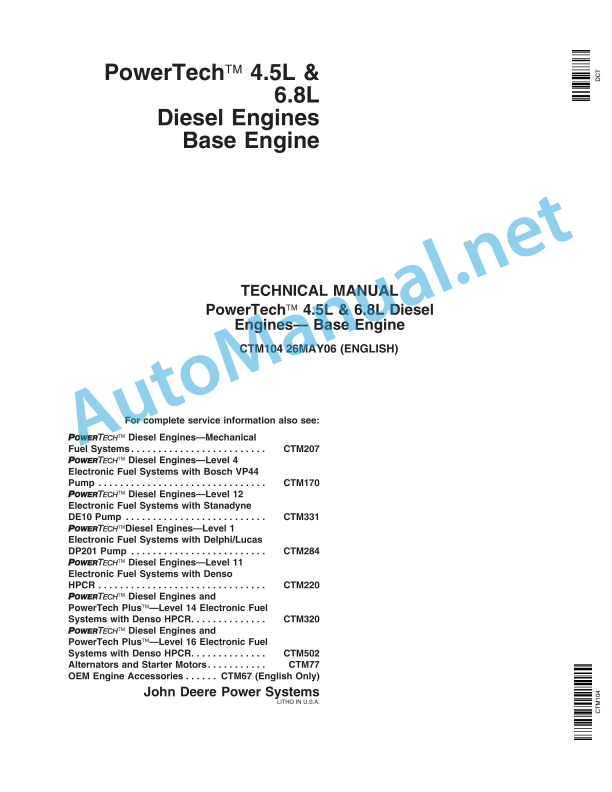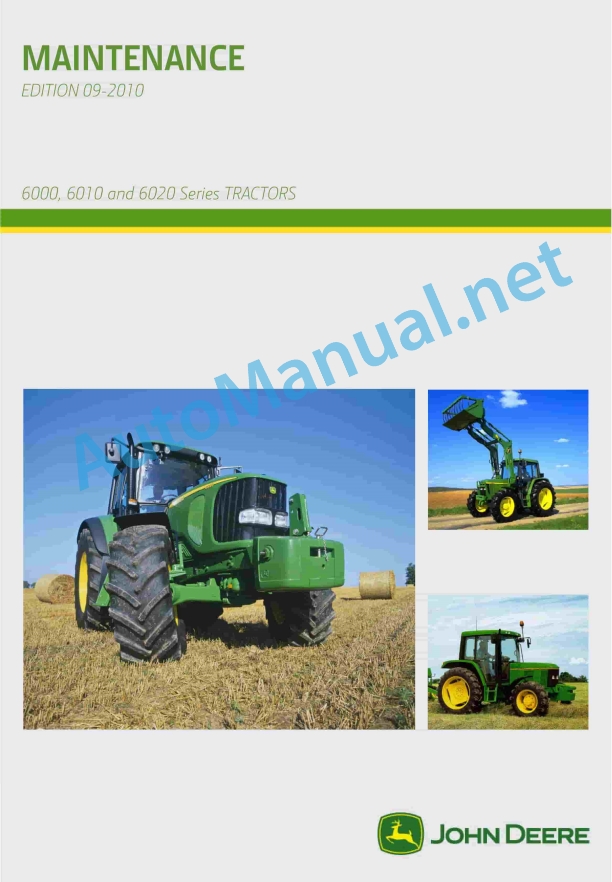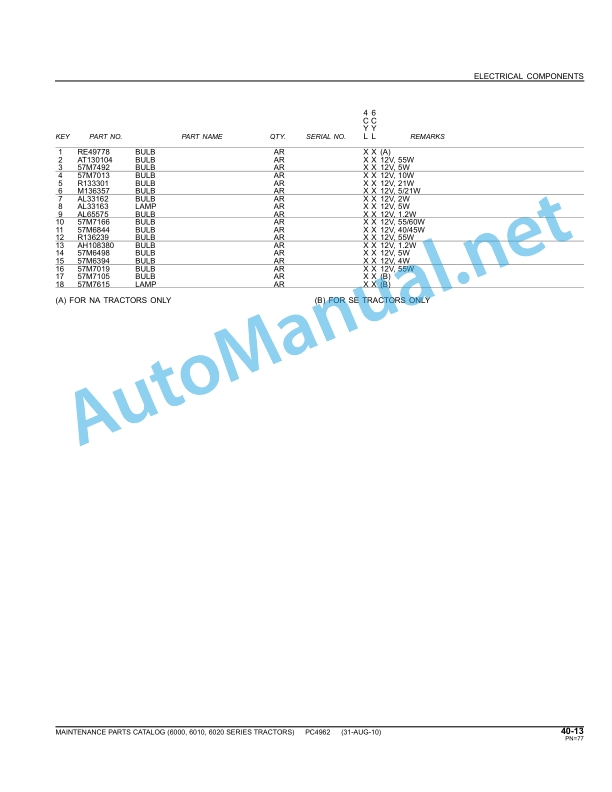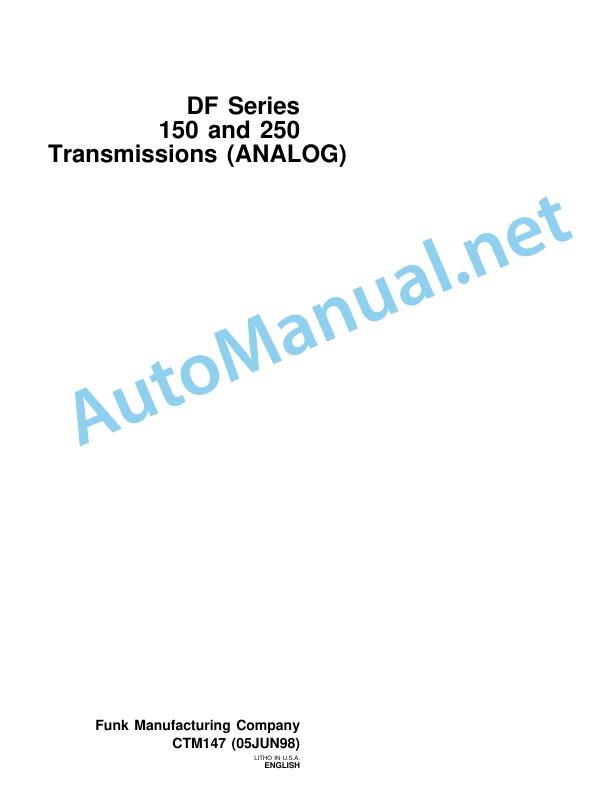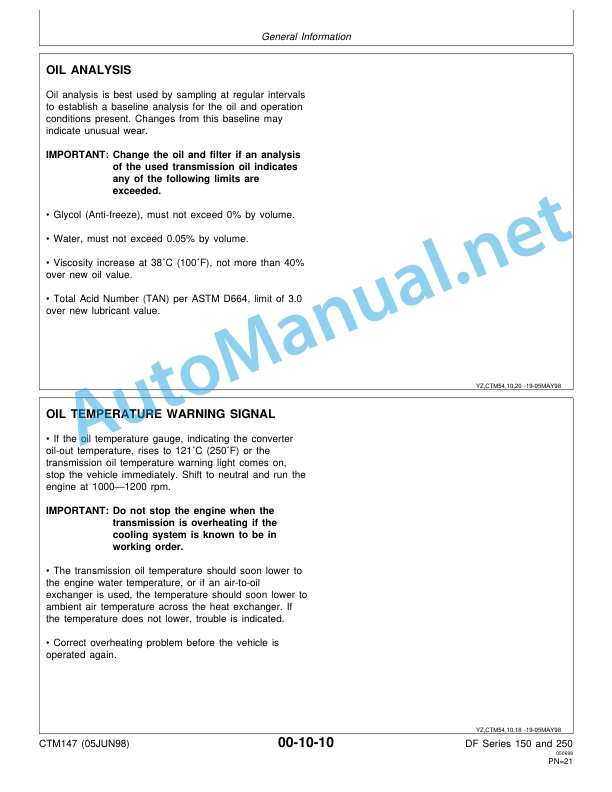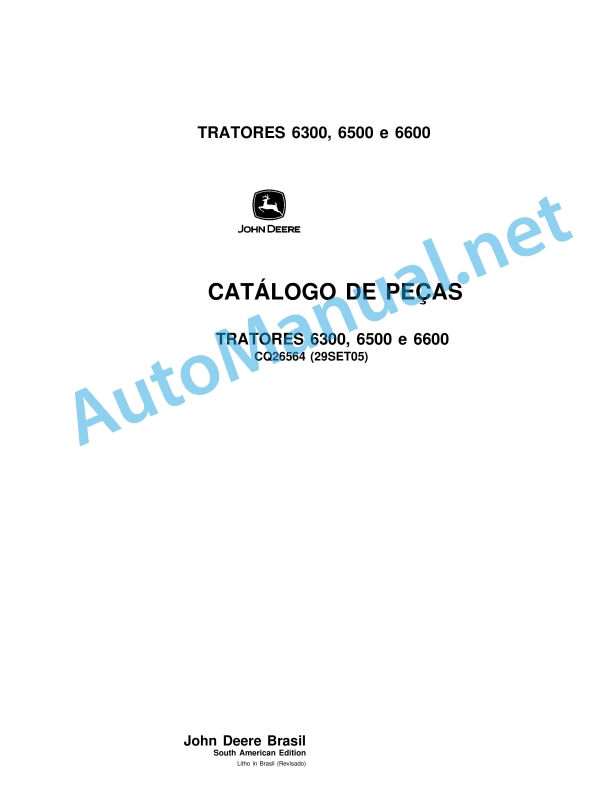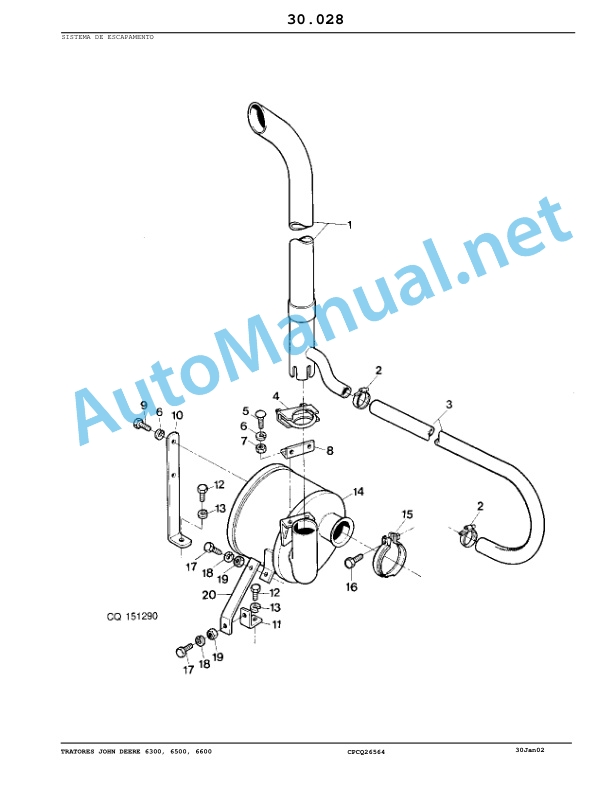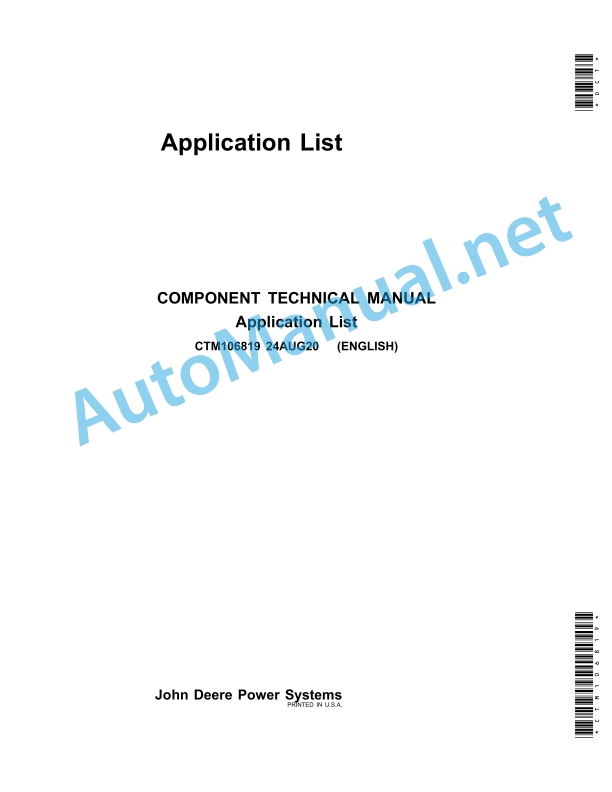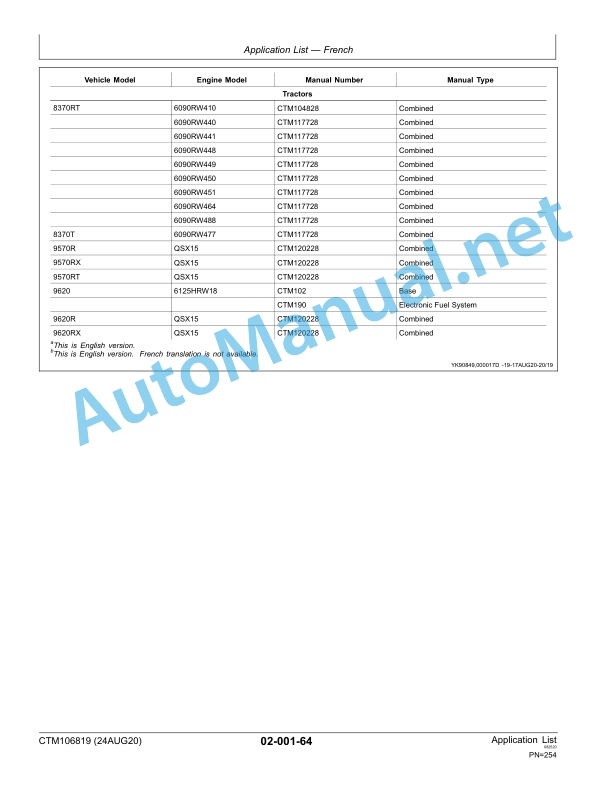Claas Avero 160 (560) Combines Operator Manual ES
$50.00
- Model: Avero 160 (560) Combines
- Type Of Manual: Operator Manual
- Language: ES
- Format: PDF(s)
- Size: 51.8 MB
File List:
00 0300 026 4.pdf
00 0300 026 4.pdf:
AVERO 240AVERO 160
1. Introduction
1.1 General information
1.1.1 Validity of the manual
1.1.2 Information relating to this instruction manual
1.1.3 Symbols and indications
1.1.4 Optional equipment
1.1.5 Qualified specialized workshop
1.1.6 Maintenance instructions
1.1.7 Information regarding warranty
1.1.8 Spare parts and technical questions
1.2 Proper application of the machine
1.2.1 Proper machine application
1.2.2 Logically foreseeable misuse
2 Security
2.1 Recognize warning signs
2.1.1 Danger symbols
2.1.2 Keyword
2.2 Safety instructions
2.2.1 Meaning of the instruction manual
2.2.2 Observe graphic danger symbols and alarm indications
2.2.3 Observe graphic danger symbols and alarm indications
2.2.4 Requirements for all people working with the machine
2.2.5 Children in danger
2.2.6 Danger zones
2.2.7 Position yourself between the machine and the head
2.2.8 Accompanying instructors during work
2.2.9 Coupling the machine with header or trailer
2.2.10 Risk of injury due to rotating shafts
2.2.11 Construction changes
2.2.12 Optional equipment and spare parts
2.2.13 Control of the machine in operation
2.2.14 Use only after correct commissioning
2.2.15 Technical status
2.2.16 Danger due to machine breakdowns
2.2.17 Comply with technical limit values
2.2.18 Danger from machine parts during coasting
2.2.19 Keep protective devices operational
2.2.20 Wear appropriate clothing
2.2.21 Remove dirt and loose objects
2.2.22 Prepare the machine for road traffic
2.2.23 Dangers when driving on the road and in the countryside
2.2.24 Park the machine safely
2.2.25 Unsuitable consumables
2.2.26 Safe handling of consumables and auxiliary materials
2.2.27 Fuel is harmful to health
2.2.28 Cooling agents are harmful to health
2.2.29 Environmental protection and waste disposal
2.2.30 Keep the cabin free of chemical materials
2.2.31 Fire hazard
2.2.32 Electric shock with danger to life due to unprotected cables
2.2.33 Behavior in the case of voltage discharge through unprotected cables and lightning strikes
2.2.34 Electrical shock from electrical equipment
2.2.35 Noise can have negative consequences for health
2.2.36 Vibrations can cause health injuries
2.2.37 Pressurized air
2.2.38 Toxic exhaust gases
2.2.39 Hot surfaces
2.2.40 Safe access and descent
2.2.41 Work only on the stopped machine
2.2.42 Maintenance work and repair work
2.2.43 Machine parts and lifted loads
2.2.44 Welding work is prohibited
2.2.45 Danger from welding work
2.2.46 Check and charge the battery
2.3 Safety signage
2.3.1 Structure of graphic hazard symbols
2.3.2 Diesel engine graphic danger symbols
2.3.3 Chassis graphic danger symbols
2.3.4 Graphic danger symbols of the hydraulic installation
2.3.5 Graphic danger symbols on the driver’s cab/platform
2.3.6 Graphic danger symbols of the power supply unit
2.3.7 Graphic danger symbols for threshing equipment
2.3.8 Graphic separation hazard symbols
2.3.9 Graphic cleaning danger symbols
2.3.10 Graphic hazard symbols for crop discharge/straw discharge
2.3.11 Graphic hazard symbols for grain harvesting
2.3.12 Graphic danger symbols on mounting parts / machine body
3 Machine Description
3.1 Summary and operation
3.1.1 AVERO overview front and left
3.1.2 Summary of the machine behind and right
3.1.3 Machine operating mode
3.1.4 Summary of Cummins B6.7 Diesel Engine
3.1.5 Perkins 1206F-E70TA Diesel Engine Summary
3.1.6 Perkins 1106D-E70TA Diesel Engine Summary
3.1.7 Summary of refrigeration groups
3.2 Identification plates and vehicle identification number
3.2.1 Nameplate on Cummins B6.7 diesel engine
Example for a Cummins model designation
3.2.2 Identification plate on Perkins 1106D-E70TA diesel engine
3.2.3 Perkins 1206F-E70TA diesel engine nameplate
3.2.4 Machine identification plate
3.2.5 Drive axle identification plate
3.2.6 Steering axle identification plate
3.2.7 Straw chopper identification plate
4 Control and display instruments
4.1 Cabin and driving position
4.1.1 Driver’s platform
4.1.2 Control desk
4.1.3 Column B control desk
4.1.4 Column B control desk
4.1.5 Column B control desk
4.1.6 Cab roof control elements
4.1.7 Multifunctional control
4.1.8 Central clock summary
4.1.9 Central clock summary
4.1.10 On-board reporting summary
4.1.11 Multifunctional switch
4.1.12 Driver’s seat
4.1.13 Driver’s seat
4.1.14 MATIC A/C air conditioning control element
4.1.15 Air conditioning equipment
4.2 On-board computer and display devices
4.2.1 Validity of CIS software
4.2.2 General CIS instructions
4.2.3 CIS screen
4.2.4 CIS Main Menu
Main menu operation
Main menu summary
4.2.5 Types of CIS errors and on-board informant
4.2.6 CIS error messages
5 Technical data
5.1 AVERO 240 / 160 – type 561 / 560
5.1.1 Diesel engines
5.1.2 Cummins B6.7 diesel engine
5.1.3 Perkins 1206F-E70TA diesel engine
5.1.4 Perkins 1106D-E70TA diesel engine
5.1.5 Chassis
walking speed
Measurement conditions
Characteristics
5.1.6 Tire air pressure
5.1.7 Summary of drive axle track widths
5.1.8 Summary of steering axle track widths
5.1.9 Table of track widths 1
5.1.10 Track width table 3
5.1.11 Track width table 4
5.1.12 Track width table 5
5.1.13 Track width table 6
5.1.14 Turning radius diameter
5.1.15 Brake
5.1.16 Address
5.1.17 Electrical and electronic installation
5.1.18 Sound pressure level and vibrations
5.1.19 Power Assembly
5.1.20 Threshing mechanism
5.1.21 Separation
5.1.22 Cleaning
5.1.23 Grain tank volume
5.1.24 Measurements of the grain tank discharge tube in working position
5.1.25 Machine measurements
5.1.26 Weights
5.2 Inputs
5.2.1 Lubricants
5.2.2 Coolant liquid
5.2.3 Hydraulic oils
5.2.4 Brake fluid
5.2.5 Select allowed fuel and urea solution
6 Preparation of the machine
6.1 Turn off the machine and secure it
6.1.1 Turn off the machine and secure it
6.1.2 Secure the machine so that it cannot roll
6.2 Access jobs and maintenance positions
6.2.1 Rotate the front ladder
6.2.2 Change the position of the rear ladder
6.2.3 Access to the workplace and maintenance stations
6.3 Prepare the machine for driving
6.3.1 Prepare for road traffic
6.3.2 Prepare the field trip
6.4 Adjust the machine to use for the job
6.4.1 Adjust the machine to cereal harvest
6.4.2 Adjust the machine to harvest corn
6.4.3 Adjust the machine to harvest rice
6.4.4 Adjust the rice harvesting machine to cereal harvesting
6.4.5 AVERO 240 threshing table
6.4.6 AVERO 160 threshing table
6.4.7 Screen table
6.4.8 Threshing segment
6.4.9 Pre-concave hatches
6.4.10 Clean the seed harvesting machine
6.5 Load the machine
6.5.1 Load and tie down the machine
6.5.2 Remove the hook rings
6.6 Head
6.6.1 Assemble the head
6.6.2 Prepare the bolting
6.6.3 Assemble the ratchet
6.6.4 Attach the head
6.6.5 Locking the head
6.6.6 Assemble the cardan shaft
6.6.7 Installing the multiple coupling
6.6.8 Place the cutting mechanism in working position and in transport position
6.6.9 Remove the support legs
6.6.10 Disassemble the head
6.6.11 Assemble the support legs
6.6.12 Dismantling the multiple coupling
6.6.13 Disassemble cardan shaft
6.6.14 Unlock the head
6.6.15 Unhook the head
6.7 Diesel engine
6.7.1 Take into account the fuel specification
6.7.2 Take fuel specification into account
6.7.3 Select permitted fuels and urea solution
6.7.4 Take into account the urea specification
Use of urea solution
Purity and norm of urea solution
Storage of urea solution in tanks and containers
Properties of urea solution at high and low outside temperatures
6.7.5 Use winter fuel at low temperatures
6.7.6 Heating the urea solution with low temperatures
6.7.7 Refuel the machine
Refuel urea solution
6.8 Chassis
6.8.1 Steering axle summary
6.8.2 Changing the steering axle from transport position to working position
6.8.3 Steering axle 00 0694 220
Check the free movement of the steering axle
6.8.4 Steering axle 00 0694 220
6.9 Brake
6.9.1 Check the parking brake
6.9.2 Check the service brake
6.10 Towing device
6.10.1 Assemble the coupling mouth*
6.10.2 Couple a trailer
6.10.3 Uncouple the trailer
6.11 Hydraulic system
6.11.1 Identify hydraulic oil
6.12 Electrical and electronic system
6.12.1 Install the air conditioning compressor fuse
6.12.2 Adjust the low beam
6.12.3 Change the road running light depending on the head
6.13 Cabin and driving position
6.13.1 Mount the approach mirror*
6.13.2 Adjust the approach mirror*
6.13.3 Remove the transport lock from the cabin
6.13.4 Adjusting the control resistance of the drive lever
6.14 Power supply unit
6.14.1 Check the anti-slip strips on the feed channel
6.14.2 Adjust the height of the feed chain
6.14.3 Adjust the head lowering speed
6.15 Guided by the ground
6.15.1 Check the head discharge pressure accumulator
6.16 Threshing mechanism
6.16.1 Open and close the stone collecting device
6.16.2 Dismantle and install the cover* of the stone collection device
6.16.3 Dismantle and install the cover* of the stone collection device
6.16.4 Open and close the cylinder flap
6.16.5 Dismantle and assemble preconcave segments
Dismantle wire concave segments
Dismantle the perforated preconcave segments
Assemble the preconcave segments
6.16.6 Assembling and disassembling the threshing segment (AVERO 240)
6.16.7 Dismantle and assemble the concave segments (MULTICROP concave)
6.16.8 Adjust the basic concave setting
6.16.9 Check basic concave adjustment
6.16.10 Assemble and dismantle the sheller cylinder cover plates*
6.16.11 Assemble and remove the grill* or the concave plate*
6.16.12 Assemble the final strip of the concave*
6.17 Separation
6.17.1 Dismantle and assemble the canvas bib
6.17.2 Assemble and dismantle the side cockscombs
6.17.3 Assembling and disassembling CCM cockscombs
6.17.4 Assembling and disassembling central cockscombs
6.17.5 Assemble and disassemble cockscombs for rice
6.17.6 Assemble and remove the shaker cover plate*
6.18 Cleaning
6.18.1 Dismantle the sieves
6.18.2 Assemble the screens
6.18.3 Mount souls on the screens
6.18.4 Cover and open the return
6.19 Unloading of the harvest and unloading of the chaff
6.19.1 Adjust the speed of the straw chopper
6.19.2 Turn the straw guide plate downwards and remove it
6.19.3 Assemble the straw guide plate and turn it upwards
6.19.4 Assemble the canvas bib* of the straw chopper
Assemble the rubber cloth
6.19.5 Remove the canvas apron* from the straw chopper
Remove the rubber cloth
6.19.6 Assemble and remove the cover plate* on top of the straw chopper counterblade
Install the cover plate
Remove the cover plate
6.19.7 Place the straw chopper in the sieve mounting position
6.19.8 Hook the straw guide bib high
6.20 Grain collection
6.20.1 Access and leave the grain deposit
Access and leave the shaker space
6.20.2 Open and close the grain tank lid
6.20.3 Adjust the grain tank full indicator
6.20.4 Retighten the drain screw on the grain tank discharge tube
6.21 Assembly and body parts
6.21.1 Perform a counterbalance of the machine
Fill the tires
Install the additional steering axle weight
6.21.2 Determine the additional weight of the steering axle
Steering axle type assignment
Machine and head assignment
6.21.3 Determine tire filling
6.21.4 Adjust additional weight for the steering axle
6.21.5 Open and close the side covers
6.21.6 Open and close the engine space side cover
6.21.7 Removing and installing the tailgate
6.21.8 Open and close the side cover of the grain tank discharge drive
6.21.9 Check the reversing horn
7 Management
7.1 Driving the machine
7.1.1 Pay attention to the indications for road traffic
7.1.2 Driving the machine with gear lever
Drive the machine forward
Drive the machine in reverse
Brake and stop the machine
7.1.3 Park the machine
7.1.4 Maneuver the machine
7.1.5 Towing the machine from the danger zone
7.1.6 Connecting the road traffic switch
Turn on the road traffic switch in road traffic
Switch on the road traffic switch in
7.2 Diesel engine
7.2.1 Connect the diesel engine
Allow the diesel engine to warm up when the outside temperature is below 0°. Allow the diesel engine and hydraulic system to warm up when the outside temperature is below -10°C.
7.2.2 Turn off the diesel engine
7.2.3 Adjusting the diesel engine speed
7.3 Chassis
7.3.1 Shift into gear
7.4 Brake
7.4.1 Braking the machine with the foot brake
7.4.2 Set the parking brake
7.4.3 Release the parking brake
7.5 Address
7.5.1 Take into account steering behavior
7.5.2 Adjust the steering column
7.6 Cabin and driving position
7.6.1 Emergency exit
7.6.2 Putting on the seat belt
7.6.3 MATIC A/C operating modes
7.6.4 Connect the air conditioning unit
7.6.5 Activate A/C MATIC
7.6.6 Adjust the cabin temperature
7.6.7 Manually adjust the fan speed
7.6.8 Activate ECON operation
7.6.9 Dry the cabin windows with REHEAT
7.6.10 Adjust the air flow of the air conditioning unit
7.6.11 Show outside temperature
7.6.12 Change the temperature unit
7.6.13 Turn on the air conditioning and adjust it
7.6.14 Adjust hesunshade
7.7 Power unit
7.7.1 Connect the power supply unit to the control desk
7.7.2 Disconnect the power supply unit at the control desk
7.7.3 Disconnecting the power supply unit at the multifunction controller
7.7.4 Invert the head
7.8 Guided by the ground
7.8.1 Ground guidance variants
CONTOUR variant
AUTO CONTOUR variant
7.8.2 Cutting height adjustment – record cutting height and support pressure
7.8.3 Cutting height preselection – recording cutting height
7.8.4 View support pressure on position indicator
7.8.5 View cutting height on position indicator
7.9 Threshing mechanism
7.9.1 Connect the threshing units
7.9.2 Disconnect the threshing devices
7.9.3 Graduate the concave
7.9.4 Graduate the concave
7.9.5 Connect or disconnect the sheller plate
7.9.6 Assemble or dismantle the shelling strips*
7.9.7 Clear a straw jam (AVERO 240)
7.9.8 Clear a straw jam (AVERO 160)
7.9.9 Adjust the speed of the shelling cylinder
7.9.10 Adjust the speed of the shelling cylinder
7.9.11 Control return
7.10 Separation
7.10.1 Adjust the canvas bib
7.10.2 Adjust the canvas bib
7.10.3 Observe the straw jam warning behind the separation
7.10.4 Adjust the separation grain passage control indicator
7.11 Cleaning
7.11.1 Adjust sieve widths
Adjust the upper sieve
Adjust the lower sieve
7.11.2 Adjust the fan speed
7.11.3 Adjusting the air guide plate
7.11.4 Adjust the cleaning grain passage control indicator
7.12 Unloading of the harvest and unloading of the chaff
7.12.1 Put the straw chopper into operation (turn the spreader plate distributor to the chopping position)
7.12.2 Putting the straw chopper out of service (turn the spreading plate spreader into the windrowing position)
7.12.3 Turn the spreader plate distributor
Rotate the spreader plate distributor
7.12.4 Adjusting the bed knife (standard straw chopper)
7.13 Grain collection
7.13.1 Adjust the cover plates of the grain tank filling auger
7.13.2 Adjust the grain tank filling auger cover plate
7.13.3 Remove and insert the grain tank discharge tube
7.13.4 Connecting and disconnecting the grain tank discharge
8 Incident and solution
8.1 Diesel engine
8.1.1 Diesel engine incidents
8.1.2 Shut down the overheated diesel engine
8.1.3 Summary of diesel engine malfunctions
8.1.4 Urea filling level
8.1.5 Exhaust gas aftertreatment
8.1.6 Protection against excessive loading of the diesel particulate filter
8.1.7 Manually start diesel particulate filter regeneration
8.1.8 Urea fill level, incident and solution
8.1.9 Aftertreatment of exhaust gases, incident and solution
8.1.10 Incident relevant to exhaust gases and solution
8.2 Electrical and electronic system
8.2.1 Diesel engine starting aid
Connect the diesel engine
Charge the battery
8.2.2 Open the base central electrical system
8.2.3 Shut down the base central electrical system
8.2.4 Open the roof central electrical system
8.2.5 Close the roof central electrical system
8.2.6 Base central electrical system
8.2.7 Roof central electrical system
8.2.8 Base and roof central electrical system prefuse
8.2.9 Vehicle main fuse
8.2.10 Fuse box for diesel engine
Parts Summary
Fuse box
8.3 Cabin and driving position
8.3.1 Air conditioning automation, error code table
8.3.2 Summary of breakdowns in air conditioning equipment
8.4 Head
8.4.1 Head
8.5 Power supply unit
8.5.1 Summary of feed channel faults
8.6 Threshing mechanism
8.6.1 Incidents and solutions in threshing equipment
8.6.2 Sheller cylinder
8.7 Separation
8.7.1 Incidents and solution in separation
8.8 Cleaning
8.8.1 Cleaning incident and solution
8.9 Unloading of the harvest and unloading of the chaff
8.9.1 Summary of breakdowns in harvest unloading and straw unloading
8.10 Grain collection
8.10.1 Incidents and solutions in grain collection
8.10.2 Assemble the security screw for the grain tank discharge drive
9 Maintenance
9.1 Maintenance intervals
9.1.1 Before starting the harvest
9.1.2 After the first 10 hours of service
9.1.3 After the first 100 hours of service
9.1.4 After the first 500 hours of service
9.1.5 Every 10 hours of service or daily
9.1.6 Every 50 hours of service
9.1.7 Every 100 hours of service
9.1.8 Every 250 hours of service
9.1.9 Every 500 hours of service or annually
9.1.10 Every 1000 hours of service
9.1.11 Every 1500 hours of service
9.1.12 Every 5000 hours of service
9.1.13 Every 2 years
9.1.14 Every 5 years
9.1.15 After harvest
9.1.16 Maintain the machine
9.2 Greasing scheme
9.2.1 Lubricant cleaning
9.2.2 Grease the left lubrication points every 10 hours
9.2.3 Grease the right grease points every 10 hours
9.2.4 Grease the left lubrication points every 50 hours
9.2.5 Grease the right grease points every 50 hours
9.2.6 Grease the left-hand grease points every 100 hours
9.2.7 Grease the right grease points every 100 hours
9.2.8 Grease the left grease fittings every 500 hours
9.2.9 Grease the right grease points every 500 hours
9.3 Diesel engine
9.3.1 Diesel engine
9.3.2 Clean the diesel engine and assemblies
9.3.3 Clean the crankcase bleed pipe
9.3.4 Open and close the fuel system shut-off cock
9.3.5 Replacing the fuel pump prefilter
9.3.6 Empty the condensation water in the fuel prefilter
Perkins 1206F-E70TA
Cummins B6.7
Cummins B6.7 and Perkins 1106D-E70TA
9.3.7 Change the fuel prefilter in the grain elevator
9.3.8 Change the fuel prefilter in the grain elevator
9.3.9 Change the fuel prefilter on the grain elevator
9.3.10 Change the fuel filter in the diesel engine
9.3.11 Change the fuel filter in the diesel engine
9.3.12 Electrically bleed the fuel system
9.3.13 Bleeding the fuel system
Fuel Prefilter for Cummins B6.7
Fuel Prefilter for Perkins 1106D-E70TA
9.3.14 Change the urea pump filter
9.3.15 Change the urea pump filter
9.3.16 Check the diesel engine oil level
9.3.17 Fill diesel engine oil
9.3.18 Change the diesel engine oil and oil filter
9.3.19 Check the coolant level
9.3.20 Check the antifreeze protection of the coolant
Use of ready-mixed coolant
Use of anti-corrosion agents and concentrated antifreeze
9.3.21 Change the coolant
9.3.22 Drain the coolant
9.3.23 Fill coolant liquid
9.3.24 Prepare the air gun for cleaning the cooling assemblies
9.3.25 Clean the radiator screen
9.3.26 Clean the refrigeration unit
9.3.27 Clean the diesel engine air filter
9.3.28 Change the diesel engine air filter element
9.3.29 Change the safety cartridge of the diesel engine air filter
9.3.30 Check the coolant hoses
9.3.31 Check the air hoses
9.3.32 Preserve the diesel engine
9.4 Chassis
9.4.1 Raise the machine on supports
Raise the machine under the axles
Lift the machine from behind under the chassis
9.4.2 Check wheels, tires and tire pressure
9.4.3 Check wheel nuts and wheel studs
Drive shaft
steering axis
9.4.4 Remove and install the wheels
9.4.5 Clean the drive axle
9.4.6 Check the oil level of the drive axle reducers
9.4.7 Drain the oil from the drive axle reduction gear
9.4.8 Fill the drive axle reduction gear oil
9.4.9 Check the oil level of the drive axle gearbox
9.4.10 Drain the oil from the drive axle gearbox
9.4.11 Fill oil in the drive axle gearbox
9.5 Brake
9.5.1 Check the brake fluid level
9.5.2 Check the brake shims and brake discs
9.5.3 Brake
9.6 Drives
9.6.1 Drives
9.6.2 Adjust the drives
9.6.3 Adjust the belt (R01)
9.6.4 Check the belt (R02)
AVERO 240
AVERO 160
9.6.5 Adjust the belt (R03)
9.6.6 Adjust the belt (R04)
9.6.7 Adjust the belt (R05)
9.6.8 Adjust the belt (R06)
9.6.9 Adjust the belt (R07)
9.6.10 Adjust the belt (R08)
9.6.11 Adjust the belt (R09)
9.6.12 Adjust the belt (R10)
9.6.13 Adjust the belt (R15)
9.6.14 Adjust the belt (R16)
9.6.15 Adjust the belt (R40)
9.6.16 Adjust the belt (R41)
9.6.17 Adjust the belt (R42)
9.6.18 Adjust the belt (R44a) / (R44b) / (R44c)
9.6.19 Adjust the belt (R45)
9.6.20 Adjust the chain (K55)
9.6.21 Adjust the chain (K56)
9.6.22 Adjust the chain (K57)
9.6.23 Adjust the chain (K58)
9.7 Hydraulic installation
9.7.1 Hydraulic system
9.7.2 Check the tightness of the hydraulic system
9.7.3 Check the hydraulic hoses
Marking of hydraulic hoses
9.7.4 Check the oil level of the hydraulic system
9.7.5 Change the oil, oil filter and ventilation filter of the hydraulic oil tank
Drain oil
Fill oil
9.7.6 Clean the hydraulic tank filler filter
9.7.7 Bleed the hydraulic cylinder of the headstock transverse adjustment
9.8 Electrical and electronic system
9.8.1 Electrical equipment
9.8.2 Disconnect the battery separator switch
9.8.3 Check the battery acid level
9.8.4 Welding work on the combine
9.9 Cabin and driving position
9.9.1 Air conditioning equipment
9.9.2 Clean and change the cabin air filter
9.9.3 Clean the cabin circulating air filter
9.9.4 Connect the air conditioning installation after prolonged inoperative times
9.9.5 Start the air conditioning unit after having been inoperative for a long time
9.9.6 Control the humidity saturation of the filter dryer of the air conditioning unit
9.10 Power supply unit
9.10.1 Place the safety support in the feed channel
9.10.2 Remove the safety support in the feed channel
9.10.3 Adjust the feed chains
9.10.4 Adjust the feed chain friction clutch
9.10.5 Check the friction plates in the feed channel
9.11 Separation
9.11.1 Check the canvas bib
9.12 Unloading of the harvest and unloading of the chaff
9.12.1 Check the straw chopper
9.12.2 Change the chopping blades of the straw chopper
Change worn chopper blades
Example: Changing the outer chopper blades
Example: Changing the inner chopper blades
Change the cereal chopper blades
Change the corn chopper blades
9.13 Grain collection
9.13.1 Adjust the return elevator chain
9.13.2 Adjust grain elevator chain
9.13.3 Clean the auger trays
9.13.4 Clean the grain tank
9.13.5 Adjust the transport position of the grain tank discharge pipe support
9.14 Assembly and body parts
9.14.1 Clean the machine
9.14.2 Cleaning surfaces with adhesives
9.14.3 Protection devices
9.14.4 Check the tightness of the gears
9.14.5 Check the fire extinguisher
10 Decommissioning and waste disposal
10.1 General information
10.1.1 Decommissioning and waste disposal
11 EC declaration of conformity
11.1 AVERO 240 / 160 – type 561 / 560
11.1.1 EC declaration of conformity
12 Technical dictionary and abbreviations
12.1 Technical dictionary and abbreviations
12.1.1 Abbreviations
John Deere Parts Catalog PDF
John Deere Harvesters 8500 and 8700 Parts Catalog CPCQ24910 Spanish
John Deere Repair Technical Manual PDF
John Deere Repair Technical Manual PDF
John Deere Repair Technical Manual PDF
John Deere POWERTECH E 4.5 and 6.8 L Diesel Engines TECHNICAL MANUAL 25JAN08
John Deere Repair Technical Manual PDF
John Deere Repair Technical Manual PDF
John Deere Repair Technical Manual PDF
John Deere DF Series 150 and 250 Transmissions (ANALOG) Component Technical Manual CTM147 05JUN98
John Deere Parts Catalog PDF
John Deere Tractors 6300, 6500, and 6600 Parts Catalog CQ26564 (29SET05) Portuguese
John Deere Repair Technical Manual PDF
John Deere Application List Component Technical Manual CTM106819 24AUG20

